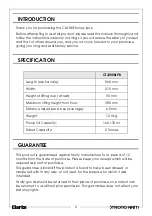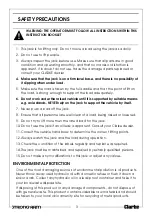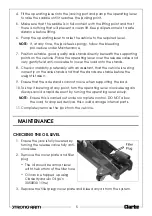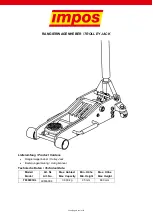
5
4. Fit the operating lever into the jacking port and pump the operating lever
to raise the saddle until it reaches the jacking point.
5. Make sure that the saddle is in full contact with the lifting point and that
there is nothing that will prevent a clean lift. Keep all personnel at a safe
distance before lifting.
6. Pump the operating lever to raise the vehicle to the required level.
NOTE:
If, at any time, the jack feels spongy, follow the bleeding
procedure under Maintenance.
7. Position suitable, good quality axle stands directly beneath the supporting
points on the vehicle. Place the operating lever over the release valve and
very gently twist anti-clockwise to lower the load onto the stands.
8. Check constantly, preferably with an assistant, that the vehicle is resting
correctly on the axle stands and that the stands are stable before the
weight is taken.
9. Ensure that the axle stands cannot move when supporting the load.
10. To stop it lowering at any point, turn the operating lever clockwise again.
Always avoid a rapid descent by turning the operating lever slowly.
NOTE:
Ensure this is carried out under complete control. DO NOT allow
the load to drop suddenly as this could damage internal parts.
11. Completely remove the jack from the vehicle.
MAINTENANCE
CHECKING THE OIL LEVEL
1. Ensure the jack is fully lowered by
turning the release valve fully anti-
clockwise.
2. Remove the cover plate and filler
plug.
• The oil should be almost level
with the bottom of the filler hole
• Oil can be topped up using
Clarke Hydraulic Oil (p/n
3050830 1 litre).
3. Replace the filler plug/cover plate and bleed any air from the system.
Summary of Contents for CTJ2000LPB
Page 7: ...7 DECLARATION OF CONFORMITY...
Page 8: ......























